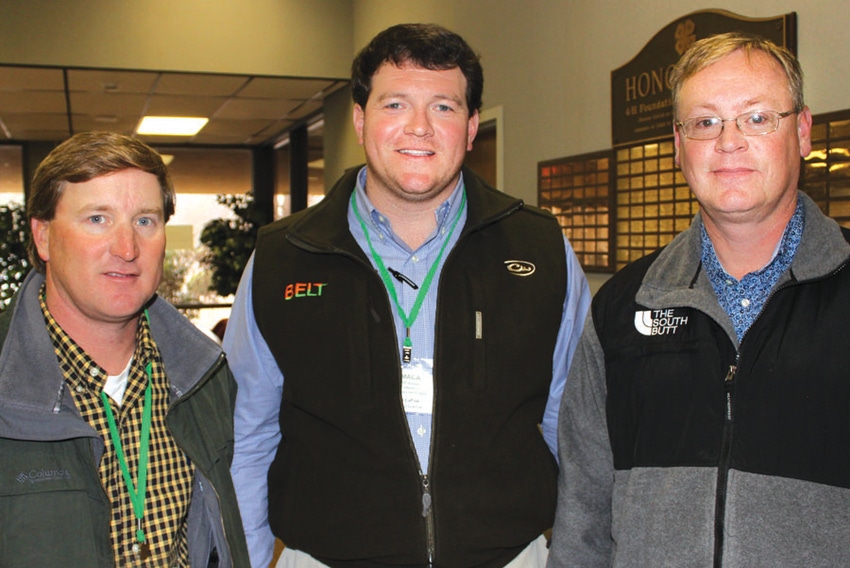
Glyphosate-resistant johnsongrass a concern in Louisiana
Glyphosate resistant johnsongrass is becoming a problem in some areas of Louisiana, says Dr. Daniel Stephenson, weed scientist at the LSU AgCenter. Research has shown, Stephenson says, that just two johnsongrass plants per row foot of soybeans can reduce yield by 16 percent when the weed is allowed to compete for four weeks, and just one johnsongrass plant per row foot of cotton can reduce yield as much as 40 percent.

Johnsongrass has now “joined the party” for glyphosate-resistant weeds, with documented hot spots in two Louisiana parishes, says Daniel Stephenson, Louisiana State University assistant professor of weed science at the Dean Lee Station at Alexandria.
“In Rapides Parish, it took 7.2 times the normal rate of glyphosate to kill 50 percent of the resistant johnsongrass population,” he said at the annual meeting of the Mississippi Agricultural Consultants Association a Mississippi State University. “In Pointe Coupee Parish, it took 10 quarts to kill half the resistant population of rhizome johnsongrass, and 3 quarts just to kill the seedlings.
Research has shown, Stephenson says, that just two johnsongrass plants per row foot of soybeans can reduce yield by 16 percent when the weed is allowed to compete for four weeks.
“For 50-bushel beans at $12, that’s a 7.2 bushel loss and $86.40 per acre you’ve cost yourself by leaving johnsongrass in the field and allowing it to compete.
“Just one johnsongrass plant per row foot of cotton can reduce yield as much as 40 percent. At 1,000 pounds of lint, that’s $300 per acre you’ve lost.”
Johnsongrass, once labeled world’s worst weed, first started to be tamed in the era of recirculating sprayers and
a 2X rate of Treflan, Stephenson says. “That did a good job of controlling johnsongrass.
“Then came the graminicides, such as Poast, Fusilade, Assure, Select, and others that gave over-the-top control. Those materials still have utility, but we’re now seeing resistance.
“In 1996, Roundup Ready crops came along, and johnsongrass was no longer an issue because glyphosate worked so well. But unfortunately, we’ve overused it and now we’re having problems with resistance similar to that in Palmer amaranth and other weeds.
“Research has given us tools with which we can manage glyphosate-resistant Palmer amaranth. We’re now finding that glyphosate-resistant johnsongrass is difficult to control because of the limited tools we have.
“And as with Palmer amaranth, there’s no single solution for fighting resistant johnsongrass — you’ve got to rotate your crops and herbicide chemistries.”
In many areas of Louisiana, where no-till production is not utilized, he says, tillage can further spread rhizomes of glyphosate-resistant johnsongrass.
The resistant weed was first found in the state in 2008, but “has been spreading rather slowly, because growers and consultants have learned a lesson with glyphosate-resistant Palmer amaranth — if they see johnsongrass surviving a glyphosate application, they’re quick to get out there and remove it. They’re doing all they can to shut down resistant johnsongrass and keep it from spreading.”
Materials such as Fusilade, Assure, and Select “are beginning to lose effectiveness on this resistant population,” Stephenson says. “Thus far we’ve not documented multiple resistance, but if we keep banging away with graminicides the way we have the last couple of years, we unfortunately are likely to see multiple resistance develop. Past experience has shown that when we rely on one chemistry too long, we have problems.”
In cotton, if johnsongrass is not controlled, he says, “you can have all kinds of problems with picker heads when you start harvesting the field.
Control options limited
“Preliminary research indicates that 3.33 pints of Command can suppress early season growth of johnsongrass, but this treatment is quite expensive. What you do see, though, is Palmer amaranth, and I had Command-treated plots I couldn’t harvest because there was so much Palmer amaranth.
“We really don’t have an answer to control johnsongrass pre-emerge in cotton other than a super-high rate of Command. With LibertyLink cotton, Liberty postemergence does a pretty fair job — it doesn’t kill the johnsongrass; it just burns it black and allows the cotton to outgrow it.”
For Ignite or Liberty, Stephenson says, “It took three applications of 29 ounces to get possibly 90 percent control of johnsongrass. We’re stretching ourselves to the max with LibertyLink and Ignite, but it’s about the only thing we’re finding that will work in cotton to control johnsongrass.
“For Roundup Ready flex cotton, we’ve found that mixing a graminicide and glyphosate will provide something of a synergistic effect on glyphosate-resistant johnsongrass; however, this application still places selection pressure on graminicides, which may lead to resistance.
“Liberty, LibertyLink cotton, and glytol LibertyLink are looking like our best tools, but we need more research in this area”
Louisiana data show “corn may be the best place to fight this monster,” Stephenson says, “because we have some very good tools for dealing with glyphosate-resistant johnsongrass in that crop.
“In our trials, we’ve obtained 85 percent control with Corvus and adding atrazine bumps it to over 90 percent. Add a postemerge application of glyphosate and Liberty at the V4 growth stage, and you get 85 percent to 95 percent control of Palmer amaranth, morningglory, hophornbeam copperleaf, and other weeds.
“Corvus’ sister herbicide, Capreno, applied at V4, provided almost 100 percent control of glyphosate-resistant johnsongrass in my research. It’s expensive, but you might use it as a spot spray.”
Controlling glyphosate-resistant johnsongrass in soybeans is very similar to techniques for cotton, Stephenson says, noting that results with herbicides such as Classic, Flexstar, and SelectMax have been inconsistent.
“For LibertyLink soybeans, applying Ignite at 22, 29, or 36 ounces on 18-inch johnsongrass, and also on sequential rates, we found no differences Liberty rate for control. The biggest difference was in the timing of the sequential applications — whether we waited three weeks after the first application for the next spray, or waited four weeks. In every situation, we increased control and increased yield by delaying the second application until the fourth week.”
Take-home suggestions for glyphosate-resistant johnsongrass, Stephenson says, include:
· “If you’re growing corn, plant a hybrid that is Roundup Ready/LibertyLink so you can spray it with glyphosate and Liberty over the top. Do not put an organophosphate insecticide in-furrow, because then you’ve lost the ability to use a number of materials that have shown good utility on johnsongrass.
· “In cotton and soybeans, a graminicide plus glyphosate will require two applications. In LibertyLink cotton or glytol LibertyLink soybeans, use Liberty followed by Liberty and a graminicide, with the first application at 12 inches to 18 inches and a sequential application four weeks later. It may take a third application.
· “If you spray glyphosate on johnsongrass and it doesn’t kill, get out of your pickup, dig it up, get it out of the field and don’t let it make seed. Flag the spot, then keep checking back to be sure no more is coming up. Don’t let the situation get out of hand, the way Palmer amaranth has in many areas of the Mid-South.
· “If you see johnsongrass in your field, you may question whether it’s resistant or maybe the sprayer just missed a spot. It doesn’t cost you anything to get out of your pickup and pull it up so it doesn’t persist and potentially cause problems in the future.
“We all know what has happened with resistance in Palmer amaranth,” Stephenson says. “We don’t want the same thing to happen with johnsongrass.”
About the Author(s)
You May Also Like



